Forward-thinking insights focused on a more sustainable tomorrow.
Building Resilience: Sustainable Strategies for Florida’s Coastal Communities
Florida’s coastal communities are positioned at the intersection of natural beauty and environmental vulnerability. The state’s extensive coastline stretches over 1,350 miles, making it particularly vulnerable to climate events like tropical storms and hurricanes. This affects many of Florida’s 23 million residents who face uncertainty and resilience challenges—and tough decisions to better protect their homes or avoid uncertainties with relocation. Florida has a heightened need for comprehensive coastal resilience strategies that state and local governments can use to address both immediate and long-term challenges. A future-focused planning approach to coastal resiliency is rooted in a deep understanding of the unique challenges faced throughout the state, coupled with sustainable funding strategies and environmental practices learned from neighboring coastal communities.
Current State of Florida’s Coastal Resilience
According to the Florida Climate Center, sea levels have risen approximately eight to nine inches over the past century, with the rate of increase accelerating in recent years. This exacerbates the risk of flooding, especially by amplifying the impacts of storm surge during tropical storms and hurricanes. Coastal communities, abundant in Florida, are increasingly experiencing these heightened risks, with a growing number of “sunny day” tidal events where flooding occurs without rainfall.
The threat of more intense tropical storms also looms large as the Atlantic hurricane season has seen more frequent and intense extreme weather. The combination of these factors results in significant economic and infrastructural impacts as Floridians must adapt to withstand these impacts with stronger building codes and improved flood defenses.
Communities are taking steps to enhance their resilience. For instance, the Florida Resilient Coastlines Program (FRCP) supports communities in planning for sea level rise and other climate impacts by providing technical assistance and funding for adaptation or mitigation projects. The Florida Department of Environmental Protection’s (FDEP) Resilient Florida Program provides grants to local governments for vulnerability assessments and adaptation planning. And the concept of living shorelines is growing in application in communities like Brevard County and Tampa Bay, providing a sustainable approach to coastal protection. These nature-based infrastructure solutions, which include the use of native vegetation and/or oyster reefs, help stabilize shorelines while providing habitat for marine life. Such initiatives are vital for enhancing the state’s resilience in the face of these persistent environmental threats, but they are not enough.
Shorefront Park Living Shoreline & Little Creek Restoration / 5:37
VHB partnered with the Village of Patchogue Shorefront Park in New York to replace a deteriorating bulkhead with a resilient, living shoreline guided by a detailed wave climate analysis-the largest permitted in New York State to date.
Challenges Facing Florida
Unpredictable Real Estate Market
Sea level rise threatens Florida’s coastal real estate, potentially lowering property values. Insurance premiums may rise significantly each year, causing disinvestment and real estate challenges. Florida’s vibrant tourism faces risks from not only immediate storm damage, but through lasting recovery needs with many residents occupying hotel rooms as temporary housing following a storm. Aging infrastructure and coastal buildings, along with bureaucratic obstacles, impede rapid recovery, requiring strategic planning and more staffing by governments to support timely rebuilding.
Policy Roadblocks
Regulatory hurdles, such as complex permitting processes, can significantly delay critical infrastructure projects, complicating recovery efforts after storms like Hurricane Ian in 2022. In areas like Pinellas County, beach renourishment can be stalled by funding, permitting, and property ownership disputes, forcing reliance on local instead of federal or state resources that can lead to incomplete protection solutions that may not withstand future storm events. These challenges can deter reinvestment and exacerbate economic disparities for current residents and businesses, highlighting the need for balanced planning that manages risks while supporting affordable redevelopment.
Vulnerable Population Impacts
Coastal resiliency efforts need to incorporate social considerations, as vulnerable communities are disproportionately impacted by climate change, often lacking the resources to adapt, recover, redevelop, or possibly relocate. Populations like elderly residents in older shoreline homes face additional displacement and affordability challenges. Prioritizing equity and engaging many different stakeholders in resiliency planning helps build inclusive resilience.
Grants + Funding
An overarching concern for Florida’s local governments is securing funding—both current and future—and effectively programming labor to address resilience challenges. Local governments like Lee County have accessed resiliency funding via the U.S. Department of Housing and Urban Development (HUD) Community Development Block Grant Disaster Recovery (CDBG-DR) funds, but obtaining these funds can have caveats. Homeowners who have begun renovations to facilitate immediate recovery needs may disqualify themselves from federal assistance, complicating rebuilding. This underscores the need for more effective communication and education about housing and rebuilding strategies.

VHB’s integrated approach to a Regional Post-Disaster Resiliency Plan in the Tampa Bay area involves environmental services, planning, and technology teams developing an interactive GIS dashboard to help evaluate risk via vulnerability assessments for floods, wind, rainfall, and more.
Strategies for Enhancing Coastal Resilience
Public-private partnerships (P3s) offer a promising avenue for funding and implementation of resilience initiatives. The Tampa Bay Regional Post-Disaster Resiliency Plan leverages a regional collaboration between local governments and, where appropriate, private sector partners to enhance regional resilience in the aftermath of natural disasters with adoption of comprehensive post-disaster planning frameworks. This involves fostering collaboration between local governments with different approaches to recovery—identifying vulnerabilities, streamlining communication, and appropriately allocating resources during multi-jurisdictional recovery efforts.
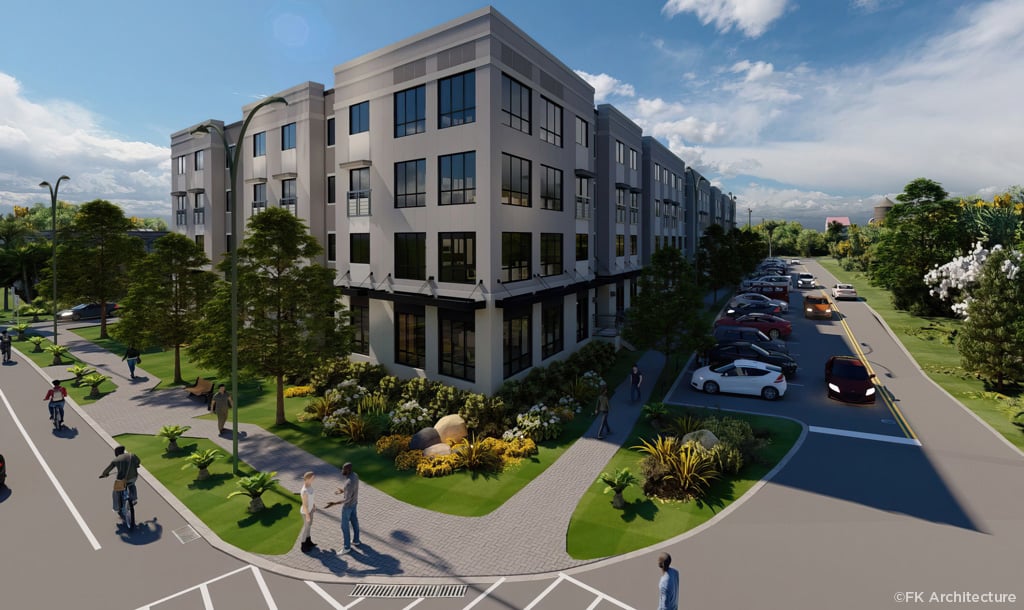
VHB’s affordable housing projects like Casa Bel Mar Apartments with Archway Partners in Tampa are happening with a mix of public and private partners, including local governments, housing authorities, and private developers. Landscape and irrigation design insight resulted in grading and elevation recommendations to protect buildings in a flood zone.
Innovative financing mechanisms, such as resilience bonds and green infrastructure funds, can also support recovery and redevelopment efforts. These tools enable communities to invest in infrastructure improvements that reduce risk and enhance resilience. By aligning financial incentives with resilience goals, communities can attract investment and drive sustainable development better capable at withstanding future impacts.
To enhance the resilience of infrastructure necessary to support daily needs like airports and healthcare facilities, it is crucial to prioritize capital improvement projects by safeguarding critical assets that provide operational continuity. This involves collaboration with asset management and financial maintenance teams to pinpoint essential components that must remain functional to maintain routine operations and facilitate swift response and recovery needs.
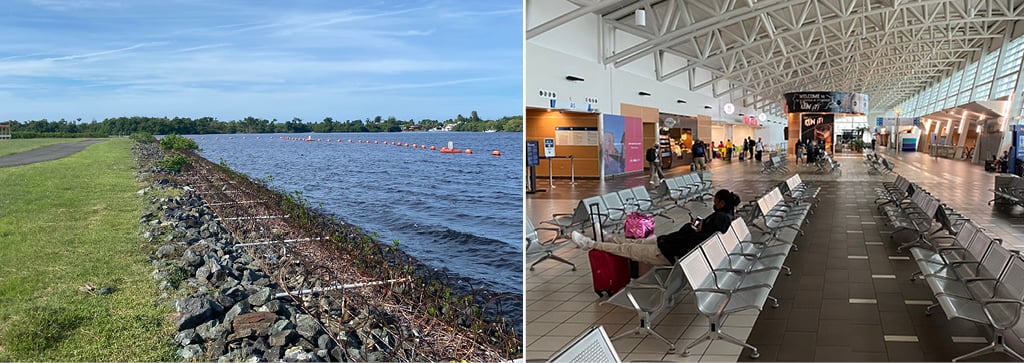
Luis Muñoz Marín International Airport is Puerto Rico’s main travel hub. VHB provided a climate vulnerability assessment as part of their Sustainability Master Plan, creating a resiliency matrix to assess the exposure of airport assets to flooding and utilizing data to evaluate their criticality.
Institutional discussions should extend to adaptation and mitigation measures that can shield these assets from hazards. Given the often-limited capital available for improvements, the focus is on balancing the level of criticality with exposure to environmental hazards to provide effective protection. In some cases, strategic decisions may involve retreating from vulnerable locations or implementing temporary barriers to provide safety and maintain functionality.
Understanding state legislation in Florida, such as the recent SB 180, helps recognize policies that may limit local authorities’ ability to quickly implement resiliency measures, such as adjusting building codes for homes in the floodplain. Local governments are concerned about their ability to address specific vulnerabilities and balance real estate market forces with resilient community redevelopment. Careful consideration should be given to state or federal policies such as SB 180 that may hinder infrastructure hardening and long-term flood mitigation efforts.
Tracking migration patterns that also shift with major disasters brings nuance to understanding when rebuilding is or isn’t economically feasible. People displaced by storms often relocate to safer locations, such as Central Florida, which saw an influx of new residents from Puerto Rico following Hurricane Maria in 2017. Migration can have immediate impacts on infrastructure and the community, from transportation systems that struggle with increased demand to schools that must make room for new students. Tracking these movements is crucial for understanding demographic changes and predicting future migration trends that could affect a community’s resiliency.
Coastal resiliency efforts extend beyond infrastructure to include the protection of endangered species that are vital to coastal ecosystems. Environmental insight helped implement measures to safeguard the habitat of the federally endangered smalltooth sawfish at a bridge reconstruction project at Little Pine Island Causeway Bridge in Florida following Hurricane Ian in 2022. Precautions included strict construction protocols designed to minimize disruptions to the local ecosystem, underscoring the interconnectedness of resilient coastal development and the preservation of biodiversity.
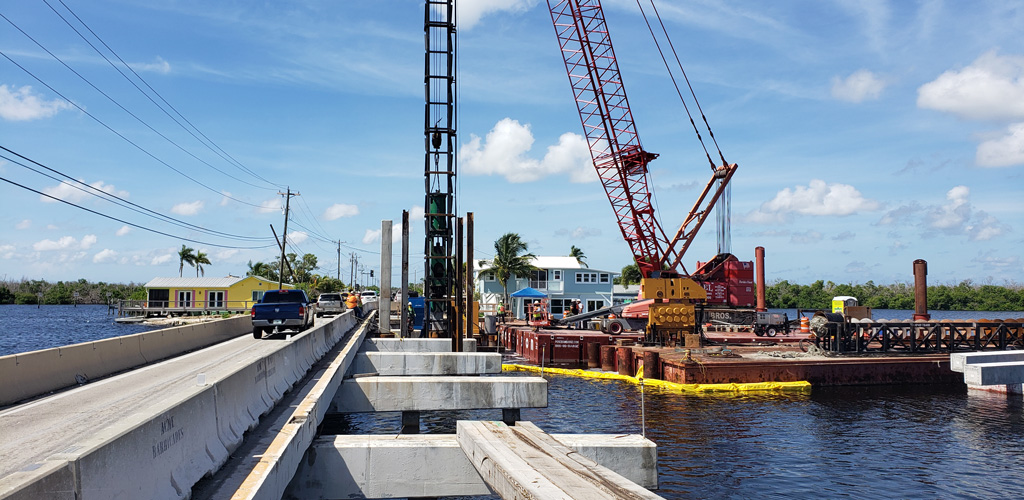
Progress and preservation happened hand in hand during the Little Pine Island Causeway bridge replacement project after Hurricane Ian in 2022, where VHB established measures to protect marine life by mitigating the impacts of understeer noise and water quality during construction.
Learning from Coastal Resiliency Across the East Coast
Florida can draw valuable lessons from coastal resiliency projects from other parts of the United States that offer innovative approaches to development. Cities that collaborate and share knowledge can continue to evolve best practices and tailor solutions to their unique contexts. This includes innovative financing solutions, proven resilient engineering strategies, and collaborative stakeholder engagement.
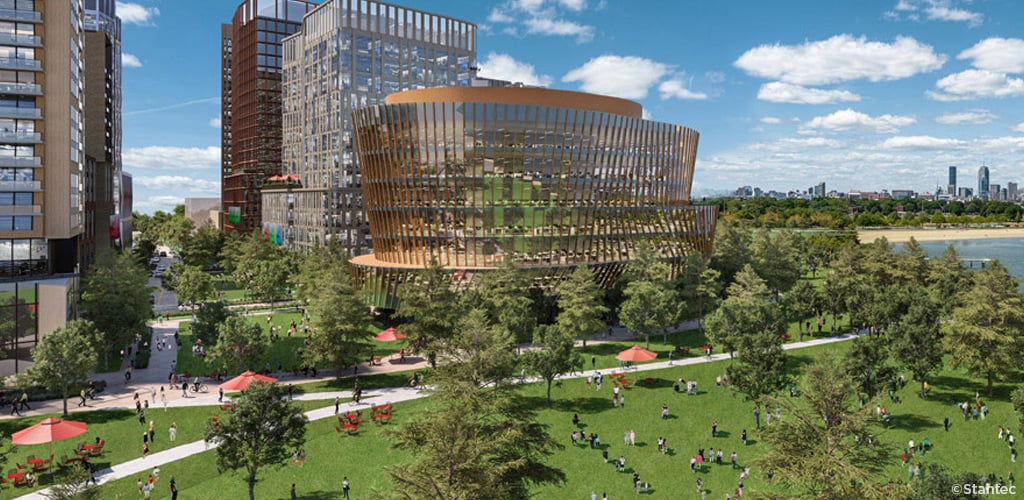
Resiliency is at the core of Massachusetts’ Dorchester Bay City project where a coastal urban site is being transformed into a vibrant, mixed-use community that can withstand the impacts of sea level rise and storm surge. Through a resiliency adaptation analysis and the creation of a nature-based living levee, the project safeguards residents, businesses, and infrastructure while also enhancing long-term climate readiness. By reimagining car-centric parcels into pedestrian- and bike-friendly spaces with strong transit connections, the development not only supports sustainable mobility but also strengthens the urban fabric of Boston’s waterfront neighborhoods. The project will be a mixed-use catalyst for community transformation. In addition to providing civil engineering and transportation planning, VHB prepared the resiliency adaptation analysis and served as lead engineer for a nature-based vegetated living levee to protect the project from sea level rise and storm surge.
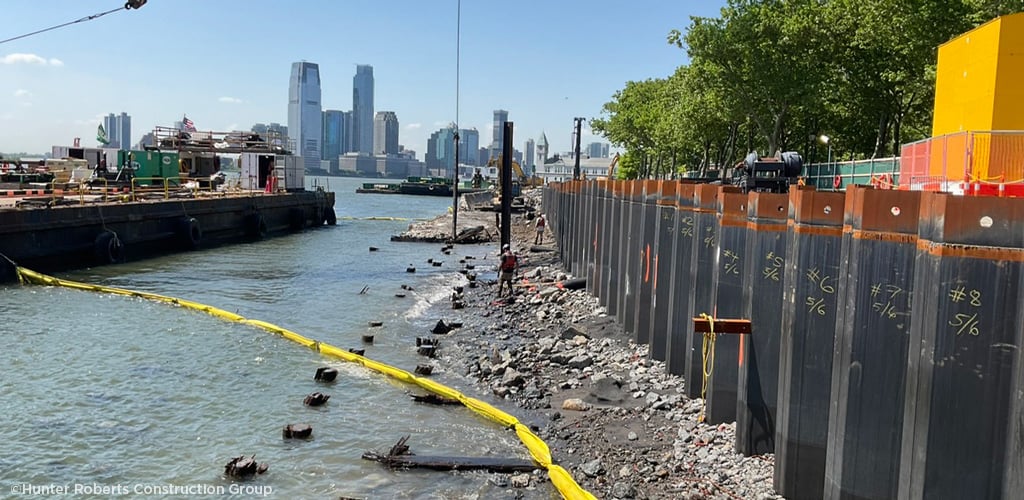
In New York, the Battery Coastal Resilience Project can serve as a valuable model for populous urban cities in constrained spaces (like Miami). As part of the larger Lower Manhattan Coastal Resiliency initiative, the project raises the wharf promenade and strengthens infrastructure to withstand sea level rise and climate impacts, while simultaneously improving public spaces. Incorporating resiliency from the start of mixed-use efforts in populated places not only safeguards the environment but also enhances community well-being and sustainability with shared use paths and civic gathering spaces. VHB developed and guided the Envision Implementation Plan for the project, working with the contractor to achieve Platinum status through sustainable construction practices.

The Ohio Creek Watershed project in Norfolk, VA, used coastal defense strategies to protect the Chesterfield Heights Historic District and Grandy Village neighborhoods from storm surge and climate-driven flooding. Measures such as living shorelines, tide gates, pump stations, and elevated roadways strengthen flood protection while improving community connection. A new stormwater park was also designed for recreation while allowing shallow inundation after flood events, transforming a challenge into a community asset. The project is a great example of layered resiliency in action: living shorelines, tide gates, pump stations, and elevated roads work together to protect the communities from storm surge and heavy rainfall.
How VHB Can Help
With a future-focused approach and community co-creation, VHB planners partner with clients to empower cities and institutions to not only withstand but thrive in the face of climate-related adversities. Our integrated approach and data-informed services help protect and enhance coastal investments and impacts. By leveraging innovative strategies, fostering proactive collaboration, and learning from successful projects across the country, we can build a more resilient future for Florida’s coastlines.
Connect with Katie and Neale today to create a sustainable and resilient future in your coastal community.




